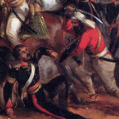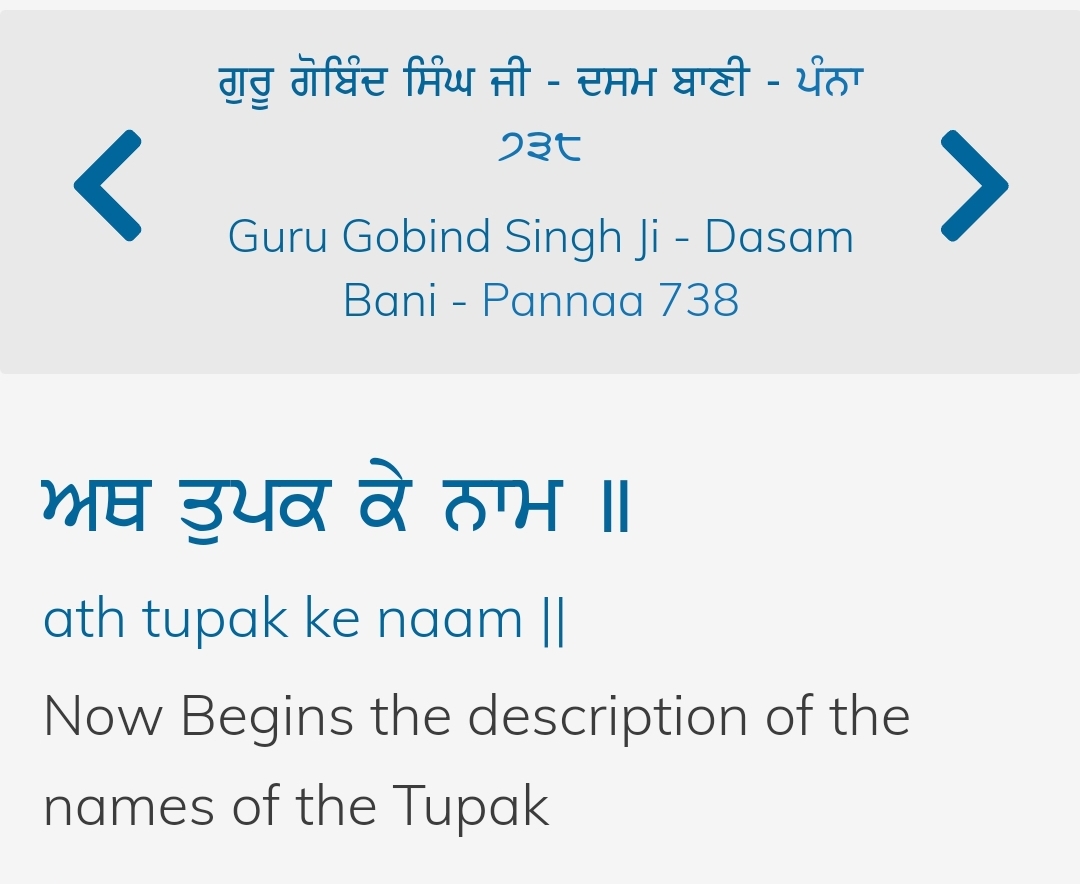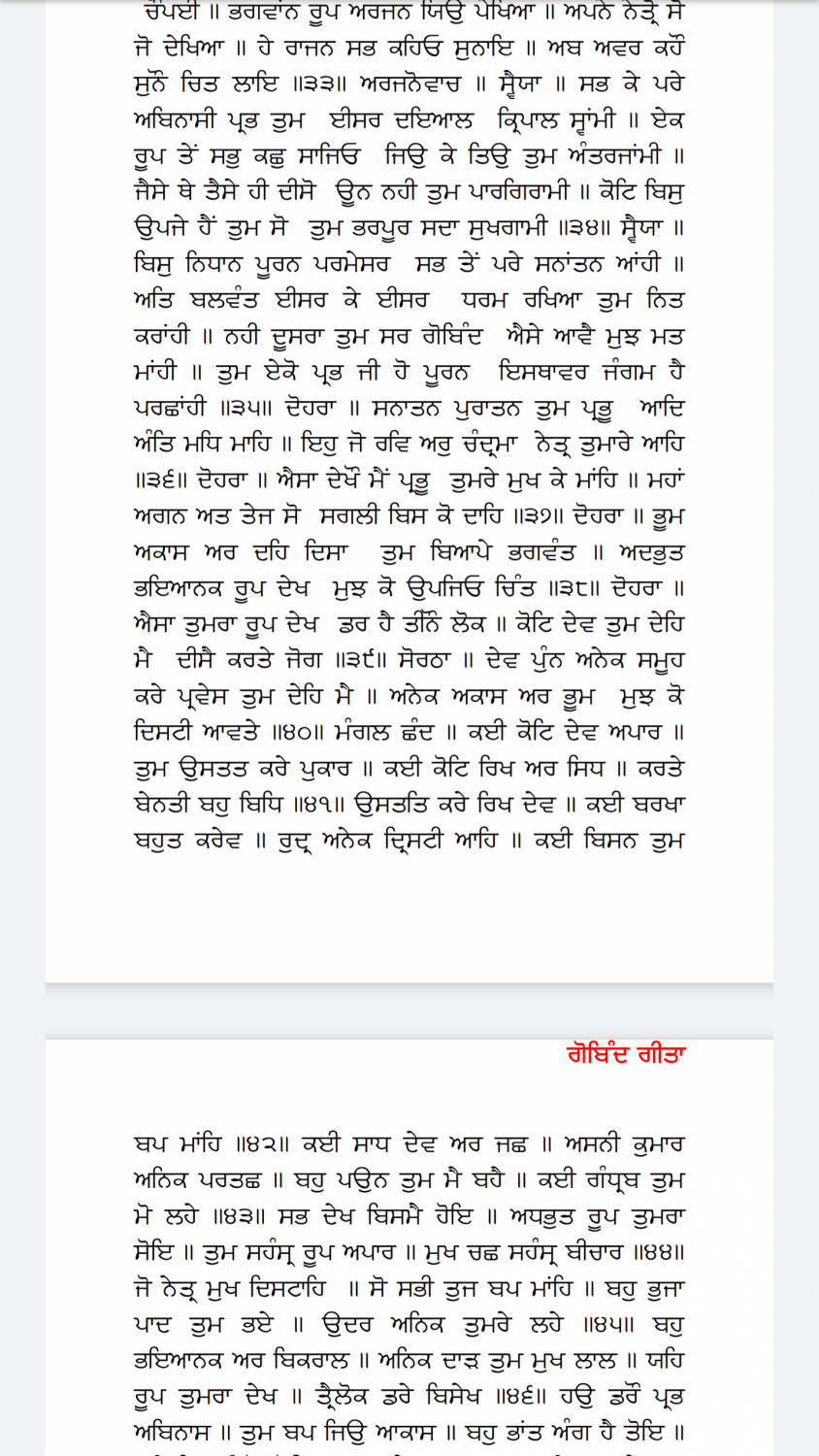Search the Community
Showing results for tags 'dasam granth'.
-
hey yeah i was just wondering why is the bani of dasam granth not included in the guru granth sahib? why did guru ji not add his bani into guru granth sahib ji. im not one of those anti dasam granth people lol! i read jaap sahib. its just that some anti dasam granth person asked me this question and i didnt know what to say! i said guru ji gave gur gaddi to guru granth sahib ji because it contains the jyoth of guru nanak dev ji and the 4 gurus that followed him. but then he was like why didnt guru gobind singh include his bani in guru granth sahib. i didnt know what to say! i was thinking that the reason might be because dasam granth was like several books? in different parts of india? and then it was collected by bhai mani singh and compiled into one. or that some of the bani is dasam granth is for bir rass while that is not the purpose of guru granth sahib ji?
-
As ever, dasmesh pita didn't leave us unprepared for any of the realities of the world, if we just open up our eyes: Sri Charitropakhyan Sahib jee Series - Charitar #105 - The tale of Taas Beg Chritar 105: Tale of Taas Beg ਚੌਪਈ ॥ Chaupaee ਅਲਿਮਰਦਾ ਕੌ ਸੁਤ ਇਕ ਰਹੈ ॥ ਤਾਸ ਬੇਗ ਨਾਮਾ ਜਗ ਕਹੈ ॥ Alimardan (a king) had a son whom the world knew as Taas Beg. ਬਚਾ ਜੌਹਰੀ ਕੋ ਤਿਨ ਹੇਰਿਯੋ ॥ ਮਹਾ ਰੁਦ੍ਰ ਰਿਪੁ ਤਾ ਕੌ ਘੇਰਿਯੋ ॥੧॥ He (Beg) came across the son of a jeweller and he was overpowered by the god of love.(1) ਤਾ ਕੇ ਦ੍ਵਾਰੇ ਦੇਖਨ ਜਾਵੈ ॥ ਰੂਪ ਨਿਹਾਰਿ ਹ੍ਰਿਦੈ ਸੁਖੁ ਪਾਵੈ ॥ He would everyday go to his house and find solace by seeing him. ਕੇਲ ਕਰੋ ਯਾ ਸੋ ਚਿਤ ਭਾਯੋ ॥ ਤੁਰਤੁ ਦੂਤ ਗ੍ਰਿਹ ਤਾਹਿ ਪਠਾਯੋ ॥੨॥ As he felt to make love with him to seek comfort, he immediately sent him his emissary.(2) ਦੂਤ ਅਨੇਕ ਉਪਚਾਰ ਬਨਾਵੈ ॥ ਮੋਹਨ ਰਾਇ ਹਾਥ ਨਹਿ ਆਵੈ ॥ The emissary tried hard but Mohan Raae (the boy) would not consent. ਤਿਹ ਤਾ ਸੋ ਇਹ ਭਾਂਤਿ ਉਚਾਰਿਯੋ ॥ ਤਾਸ ਬੇਗ ਤਾ ਸੌ ਖਿਝਿ ਮਾਰਿਯੋ ॥੩॥ When he conveyed the decision to him (Beg), he was perturbed and beat him up.(3) ਚੋਟਨ ਲਗੇ ਦੂਤ ਰਿਸਿ ਭਰਿਯੋ ॥ ਮੂਰਖ ਜਾਨਿ ਜਤਨ ਤਿਹ ਕਰਿਯੋ ॥ The emissary became furious on receiving the retribution and, ਮੋਹਨ ਆਜੁ ਕਹਿਯੋ ਮੈ ਐਹੋ ॥ considering him to be an idiotic, decided to do something. ਤਾ ਕੌ ਤਾਸ ਬੇਗ ਤੂ ਪੈਹੋ ॥੪॥ He told Taas Beg, ‘Mohan has consented to come today.’(4) ਯਹ ਸੁਨਿ ਬੈਨ ਫੂਲਿ ਜੜ ਗਯੋ ॥ ਸਾਚ ਬਾਤ ਚੀਨਤ ਚਿਤ ਭਯੋ ॥ Hearing this, his joy knew no bounds, as he took it to be true. ਲੋਗ ਉਠਾਇ ਪਾਨ ਮਦ ਕਰਿਯੋ ॥ He sent away the people and started to drink wine. ਮਾਨੁਖ ਹੁਤੋ ਜੋਨਿ ਪਸੁ ਪਰਿਯੋ ॥੫॥ Although human being, he had embraced the life of an animal.(5) ਮੋ ਮਨ ਮੋਲ ਮੋਹਨਹਿ ਲਯੋ ॥ ਤਬ ਤੇ ਮੈ ਚੇਰੋ ਹ੍ਵੈ ਗਯੋ ॥ (He thought,) ‘My heart is already in the hands of Mohan and I have become his slave since (I saw him). ਏਕ ਬਾਰ ਜੌ ਤਾਹਿ ਨਿਹਾਰੋ ॥ ਤਨੁ ਮਨੁ ਧਨ ਤਾ ਪੈ ਸਭ ਵਾਰੋ ॥੬॥ ‘Who-so-ever has a glimpse of him, sacrifices his own life over him.’(6) ਬਿਨੁ ਸੁਧਿ ਭਏ ਦੂਤ ਤਿਹ ਚੀਨੋ ॥ ਅੰਡ ਫੋਰਿ ਆਸਨ ਪਰ ਦੀਨੋ ॥ When the emissary judged he was totally intoxicated with wine, he broke an egg and spread it on his bed. ਭੂਖਨ ਬਸਤ੍ਰ ਪਾਗ ਤਿਹ ਹਰੀ ॥ ਮੂਰਖ ਕੌ ਸੁਧਿ ਕਛੂ ਨ ਪਰੀ ॥੭॥ He took away his ornaments, the clothes and the turban, and the fool remained unaware.(7) ਮਦਰਾ ਕੀ ਅਤਿ ਭਈ ਖੁਮਾਰੀ ॥ ਪ੍ਰਾਤ ਲਗੇ ਜੜ ਬੁਧਿ ਨ ਸੰਭਾਰੀ ॥ The intoxication through wine was so intense that, till morning, he did not regain consciousness. ਬੀਤੀ ਰੈਨਿ ਭਯੋ ਉਜਿਯਾਰੋ ॥ ਤਨ ਮਨ ਅਪਨੇ ਆਪ ਸੰਭਾਰੋ ॥੮॥ When the night had lapsed and the day broke, he managed to control his mind and body.(8) ਹਾਥ ਜਾਇ ਆਸਨ ਪਰ ਪਰਿਯੋ ॥ ਚੌਕਿ ਬਚਨ ਤਬ ਮੂੜ ਉਚਰਿਯੋ ॥ When his hand fell over his bed, the <banned word filter activated> thought over, ਨਿਕਟ ਆਪਨੋ ਦੂਤ ਬੁਲਾਯੋ ॥ ਤਿਨ ਕਹਿ ਭੇਦ ਸਕਲ ਸਮੁਝਾਯੋ ॥੯॥ And called over his emissary, who on query made him to understand thus,(9) ਦੋਹਰਾ ॥ Dohira ਮਤ ਭਏ ਤੁਮ ਮਦ ਭਏ ਸਕਿਯੋ ਕਛੂ ਨਹਿ ਪਾਇ ॥ ‘You were totally under intoxication and would not remember. ਐਸੇ ਕਰੈ ਚਰਿਤ੍ਰ ਵਹੁ ਸਕੈ ਮੂੜ ਨਹਿ ਪਾਇ ॥ Such Chritars could not be discerned by that idiotic and under the ਮਮ ਪ੍ਰਸਾਦ ਤੁਮਰੇ ਸਦਨ ਆਯੋ ਮੋਹਨ ਰਾਇ ॥੧੦॥ ‘Mohan Raae, on my persuasion, had come to your house.(10) ਚੌਪਈ ॥ Chaupaee ਮੋਹਨ ਤੁਮ ਕੋ ਅਧਿਕ ਰਿਝਾਯੋ ॥ ਭਾਂਤਿ ਭਾਂਤਿ ਕਰਿ ਭਾਵ ਲਡਾਯੋ ॥ ‘Mohan gave you pleasure by indulging in various gesticulations. ਤਬ ਤੁਮ ਕਛੁ ਸੰਕਾ ਨ ਬਿਚਾਰੀ ॥ ਭੂਖਨ ਬਸਤ੍ਰ ਪਾਗ ਦੈ ਡਾਰੀ ॥੧੧॥ ‘You were never in doubt and you gave him all your ornaments, the clothes and the turban.(11) ਤਾ ਸੋ ਅਧਿਕ ਕੇਲ ਤੈ ਕੀਨੋ ॥ ਭਾਂਤਿ ਭਾਂਤਿ ਤਾ ਕੌ ਰਸ ਲੀਨੋ ॥ ‘You made love with him lavishly, ਬੀਤੀ ਰੈਨਿ ਪ੍ਰਾਤ ਜਬ ਭਯੋ ॥ ਤਬ ਤੁਮ ਤਾਹਿ ਬਿਦਾ ਕਰਿ ਦਯੋ ॥੧੨॥ and when the day broke you bade him good-bye.(12) ਤਬ ਤੇ ਅਧਿਕ ਮਤ ਹ੍ਵੈ ਸੋਯੋ ॥ ਪਰੇ ਪਰੇ ਆਧੋ ਦਿਨ ਖੋਯੋ ॥ ‘Since, then, you have been sleeping, nonchalantly, and half the day has gone by. ਮਿਟਿ ਮਦ ਗਯੋ ਜਬੈ ਸੁਧ ਪਾਈ ॥ ਤਬ ਮੋ ਕੌ ਤੈ ਲਯੋ ਬੁਲਾਈ ॥੧੩॥ When the effect ofthe intoxication wore off, you called me over.’(13) ਯਹ ਸੁਨਿ ਬਾਤ ਰੀਝਿ ਜੜ ਗਯੋ ॥ ਛੋਰਿ ਭੰਡਾਰ ਅਧਿਕ ਧਨੁ ਦਯੋ ॥ The imbecile was appeased on learning this and, from his treasure, gave him lot of riches. ਭੇਦ ਅਭੇਦ ਕਛੁ ਨੈਕੁ ਨ ਚੀਨੋ ॥ ਲੂਟ੍ਯੋ ਹੁਤੋ ਲੂਟਿ ਧਨੁ ਲੀਨੋ ॥੧੪॥ He did not distinguish between the truth and deception and squandered his wealth.(14) ਯਹ ਚਰਿਤ੍ਰ ਵਹ ਨਿਤਿ ਬਨਾਵੈ ॥ ਮਦਰੋ ਪ੍ਯਾਇ ਅਧਿਕ ਤਿਹ ਸ੍ਵਾਵੈ ॥ Now (the emissary) set off on this design everyday, and put Beg into sleep with excessive wine. ਸੁਧਿ ਬਿਨੁ ਭਯੋ ਤਾਹਿ ਜਬ ਜਾਨੈ ॥ ਲੇਤ ਉਤਾਰਿ ਜੁ ਕਛੁ ਮਨੁ ਮਾਨੈ ॥੧੫॥ When he would realize he was in deep slumber, he would do whatever he liked.(15) ਦੋਹਰਾ ॥ Dohira ਮਦਰੋ ਅਧਿਕ ਪਿਵਾਇ ਕੈ ਮੂੰਡ ਮੂੰਡ ਲੈ ਜਾਇ ॥੧੬॥ influence of wine got his head shaved off (lost all his wealth).(l6)(1) ਇਤਿ ਸ੍ਰੀ ਚਰਿਤ੍ਰ ਪਖ੍ਯਾਨੇ ਪੁਰਖ ਚਰਿਤ੍ਰੇ ਮੰਤ੍ਰੀ ਭੂਪ ਸੰਬਾਦੇ ਇਕ ਸੌ ਪਾਚ ਚਰਿਤ੍ਰ ਸਮਾਪਤਮ ਸਤੁ ਸੁਭਮ ਸਤੁ ॥੧੦੫॥੧੯੬੨॥ਅਫਜੂੰ॥ 105th Parable of Auspicious Chritars Conversation of the Raja and the Minister, Completed With Benediction. (104)(1960)
- 14 replies
-
3
-
I've been reading this for the last few days. I think it's a really good study, and quite stimulating to read. I recommend it for everyone. You can download it from the fourth post in this thread: https://www.sikhawareness.com/topic/19584-debating-the-dasam-granth-by-robin-rinehart/
- 28 replies
-
- dasam granth
- study
-
(and 1 more)
Tagged with:
-
-
Never heard it before and it caught my attention on a radio station, I'm guessing its from Dasam Granth
- 6 replies
-
3
-
- dasam granth
- prithi chand
-
(and 1 more)
Tagged with:
-
Gobind Gita is not a translation of Bhagwad Gita. It's an adaption. In 11th chapter, under 'arjun vaach' , the last line of 42nd chhand reads: Kayee bisan tum bapp maahi This means there are many vishnus(krishans) in the body of Akal Purakh. This means Gobind Gita is an adaption and not a translation.
-
-
My friend is an amritdhari nitnemi Singh. He got married an year back. After marriage, he came to know his father in law is a missionary "sikh". He regularly debates with my friend that Dasam Granth is all fake and there is no need for khande baate da amrit. My friend's wife also supports her father. My friend is confused and doesn't want to hv a child in such a family. what shud he do?
-
Vjkk vjkf should we eat from and associate ourselves, with people who do nindya of gurbani. Ie saying Sri Dasam Granth Ji isn’t bani etc.
-
Bhai Nand Lal ji dint know how to write poetry in Rubayee chhand. So Dasmesh Pita spoke a Rubayee from His Lotus Mukh and bhai nand lal ji wrote his Rubayeean after listening to this Rubayee of Guru Gobind Singh ji. This Rubayee is present in an old Dasam Granth sarup at Patna Sahib.
-
Erudite scholars of the Dasam Granth, and Sri Sarbloh Granth, have concluded that Kali plays an important role in both scriptures. She is a metaphor for associating femininity with the Akal. In this article I hope to highlight the societal, and familial factors which convinced Guru Gobind Singh Ji to utilise Kali in his works. The Dasam Granth residences a plethora of mystical-cum-spiritual metaphors which are fecund spectres of an ubiquitous vision. One such spectre is that of Kali, the dark Goddess. Evolving from a primeval genesis, Kali is presently a household deity amongst the sub-continent's denizens. Possessing a bloody historicity, to rival that of the Mexica pantheon, Kali for the Khalsa is not a reverential deity but a figurative utility for it's femininity. The often bloody historicity of the Khalsa has marginalized it's feminism, in pursuit of a more hyper-masculine monomania. Despite it's Gurus' emphasis on gender equivocalism, the latter principle is found ardently lacking in practice. Even today the pseudo-inter religious governing body, the SGPC, veto's women from performing Kirtan in the cardinal Darbar Sahib. A similar strain is also visible in the collective Sikh psyche of today. Despite acknowledging the existence of a formless God in their ethos, they will still opt for a more patricentric God in an emulation of Semitism. Ironically this is a notion which directly contradicts the feminism invoked in the Dasam Granth. To understand why the Dasam Granth utilises Kali, to showcase femininity, one has to understand the historic milieu orbiting it's creation. Authored by Akali-Nihung Guru Gobind Singh Ji, it was written at a time when the societal segregation of Hinduism was at it's peak, and subsequent Islamic invasions had divided sub-continental society in believer and non-believe. The elite strata, of Hinduism, had escaped the greater Islamic penchant for persecution via allying themselves with the Mughal dynasty. Approving the latter course, the Mughal nucleus had readily allowed the latter a constrained practice of their faith. Summarily the nadir strata of Hinduism now faced two dangers. The orthodox hegemony lead by the fanatical Brahmins, or religious clerics, and the whims of Islamic radicals. Simultaneously the Brahmins restrained the performance and observance of religiosity to themselves and their male hierarchy, whilst forbidding women and the servile classes from emulating them. In the periods which followed the servile classes, and women, were slowly deprived of their deities, until penultimately Kali was left. Kali herself was perceived as being an ostracised deity by the Brahmins. Born during a mythical era of warfare, her figurative symbolism had been lost through the ages until ultimately her figure was defined in numerous modes. For the ostracised layers of Hinduism she represented a sporadic escape, an hearkening to an era where she would manifest and slaughter the malesh (filth) plaguing them. Her persona spoke volumes to the Guru who not only wanted to parent a distinct socio-religious parcel but also uplift the proletariat regardless of the latter's allegiances, associations and beliefs. Decrying her worship, he nonetheless adopted her as a clandestine metaphor for his literary works. Kali's spectral prowess over death was employed by him to depict the maternal aspect of the Akal, or the deathless entity. Simultaneously her ability to consume time was another element which he favoured and aligned with the Akal who fluidly exists over time and it's offshoots. Other factors, which were pivotal, in the Guru's adoption of Kali are found in his own life and hierarchy. Wendy Doniger argues that 'other people's myths' assist one in bettering one's own persona and traits. These 'other myths' provide an anti-inertial, and diverse, balance in one's understanding of one's own life and environment. The Khalsa Gurus' resided during a time when the folklore of Hinduism was a sub-continental phenomena, thus to assist their apostles in understanding their own unique dictums they employed well-recognised and known figures to assist them. His predecessor's anti-inertial devices were not lost on the Guru, who also forwarded the latter tradition. Secondly, despite his masculine attributes and generalship he was also close to feminism himself. His father had been executed by the fanatical Aurangzeb, and he had been left in the care of a mother who had acted as a decisive vizier for him in his early years. His own grandfather, Guru Hargobind Sahib Ji, had also deputed his wife and mother as his regents when he himself was imprisoned by the Mughals. Thus his family had seen a balance between male and female paradigms, a course not lost on him. Thirdly he employed a sublime figure. Kali is not overly beauteous, but nor was her role as an embodiment of warfare. Acknowledging this reality, the Guru added her to his own growing repertoire of literal arsenals. Fourthly Kali, for the Guru, became a stereotypical element of his own war against the contemporaneous polity. The dark, almost devilish, goddess wars against injustice in order to liberate her pantheist brethren. Simultaneously the Guru also uplifted the servile out castes of his milieu and armed them to fight the tyranny inflicted upon them. In Kali he found a kindred spirit and acknowledged this element in his writings. Fourthly the Guru gifted a parental Kali to the embryonic Khalsa. For him the purity of a female was beyond doubt, and the Khalsa too would have to imbue the same spirit in order to wage it's perpetual war against abibek. Conclusively, for the Guru, Kali became an integrative element of his revitalising of society. The fact that he could envision a female wielding a sword depicts the importance of both masculinity and femininity in human society. In the post-Guru era, Khalsa women would foster a strong tradition of warrior-dom and leadership. Mata Bhag Kaur, the Guru-mother's Mata Sahib Kaur and Sundar Kaur, Sada Kaur, Rani Jind Kaur are only few of the names which come to mind when acknowledging the matriarchal aspect of Khalsa historicity. Thus one cane easily summarise that for the Guru, Kali was a multi-faceted deity which he employed for anti-inertial and figurative upliftment. http://tisarpanth.blogspot.co.nz/2014/05/why-kali.html?view=magazine
- 3 replies
-
3
-
- dasam granth
- kali
- (and 8 more)
-
So, i was looking at websites such as Islam-Sikhism and they mention Charitrapakhyan alot which is from Dasam Granth. Please discuss it because i can't see any forums doing so and this absence can cause preachers from other faiths to attack Sikhi. Some people say that Charitrapakhyan is contradictory to the message in Guru Granth Sahib Ji.
-
So, I was reading this book called Life of Guru Nanak Dev Ji and His Teachings by Dalip Singh. In it he tells how in chapter 2 of Bachitar Natak Guru Ji tells how the world was created. It says "When the formless God effected the expansion of the universe by uttering a word, (Oankar) He created the Earth. At the onset He created the matter of the five elements (Maya), from it a most beautiful and powerful king named Kalsain (Vishnu) emerged. The second king produced was Kalkait (Brahma) and the third Koorrbaras (Shiva). The fourth was Kaldhuj (Mahavishnu), from Whom the whole creation emerged. God has thousands of beautiful eyes and thousands of lovely feet. He has enthroned Himself on the bed cushion pf multi-headed Hydra Serpent and He is remembered by the people, the One seated on the coiled body of Hydra Serpent. God extracted wax from one of His ears, from which Madh and Kitab were produced. He then extracted wax from the other ear, from which this universe was created. He then cursed Madh and Kitab to be killed. Their body fluids were thrown into the ocean. The gluey and oily matter of their body fluids began to float on the surface of water and from thence onward the creation was named after Madh. Those who perform good deeds in this universe are remembered as godly persons, while the evil doers are called demons." It is very interesting to see what Guru Ji wrote. After this Dalip Singh Ji said "Sri Guru Gobind Singh Ji in this myth first gives ideas of Guru Nanak as Given in Japji, that the Universe was brought into existence by utterance of One Word by God. In this way God created the Three Gods of Hindu Trinity, Brhama, Vishnu, Shiva, signifying creation of Matter (Maya) of three modes, from which the whole universe was created. God is further stated to be resting on the coils of the body of Hydra Serpent. This myth is the modification of the Puranic Myth of Creation." Thoughts
-

Maharajah Ranjit Singh and the Sikh Scriptures
puzzled posted a topic in GURBANI | SAKHIAN | HISTORY
Ranjit Singh the Maharajah of Panjab had full faith in both Scriptures: Guru Granth Sahib and Sri Dasam Granth Sahib. He undertook Vak from Guru Granth Sahib before undertaking his military expeditions. He also commissioned manuscript copies of the Sikh Granths by artisans in his court and beyond. He also ensured that the Granth Sahibs were carried on his expeditions. The following quote by Mufti ‘Ali’ ud-Din shows the respect that was paid to the Granth Sahibs in the Sikh empire:The maharaja maintained an elaborate establishment of Bhais (Sikh priests), one or two of whom held the charge of every Sikh shrine in the Punjab. There was a separate estate attached to every shrine, the produce of which was enjoyed by the incumbent. He was always attended on his tours by a priest with a volume of each of the two chief scriptures [Adi Granth and Dasam Granth]. They were wrapped up in rich pieces of silk, placed in a cot under a big canopy, and thus borne from one place to another. A special military escort was provided, each member of which carried a Sikh banner. The procession was often followed by a number of priests on elephants. Besides this, every regiment had its own volumes of the Granths and religious insignia. Even the ministers of state carried separate copies of the Granths on their journeys.Ibratnama, by Mufti 'Ali ud-Din, folio 356, Quoted from The Punjab as a Sovereign State (1799-1839), Gulshan Lall Chopra, (1928), Lahore, p 204 -
I have a question for someone knowledgeable. If a Sikh doesn’t believe in the dasam Granth or sarbloth Granth but does believe in the SGGS, is he still considered a Sikh? i ask because if someone has an issue with the Ragmala even though it’s in the SGGS, they are still sikhs so there shouldn’t be an issue with the other two Granth right ?
-
gurfateh, guru-sangat i was listening to a mixtape the other day, and there is this part in it where they start by saying "niraj chhand", and it says "dhhu dhhu myan te kirbaan yu nikaal hai" i want to know if this is a bani. if it is, what bani is it? i asked some of my friends and they think it could be sri sarbloh granth, panth prakash, or sooraj prakash. please let me know as soon as possible. wahegurujikakhalsawahegurujikifateh
-
- nihang
- sri sarbloh granth
-
(and 3 more)
Tagged with:
-
http://www.panjabdigilib.org/webuser/searches/displayPage.jsp?ID=41476&page=1&CategoryID=12&Searched=
-
Good information on first 6 chapters of Gobind Gita
shastarSingh posted a topic in WHAT'S HAPPENING?
http://www.panjabdigilib.org/webuser/searches/displayPage.jsp?ID=3331&page=1&CategoryID=1&Searched=W3GX&sbtsro=0 -
Been two weeks and read first 100 verses of Charitrpakyaan. It's poetic. It's also interesting and will make one thing "Damn! did women / men really fool the opposite gender like that?" we're talking unbelievable lies, women lying at point blank range and their husbands fall for it, how women used charitrs (mainly words) to get out of sticky situations. And... the husband (mainly kings) fall for it! Makes one think "OH! COME ON! U just caught her in that position- what u mean u believe her?" HOWEVER! Grasping this Bani makes one think... are we following in these steps? how many times have we used Charitrs? (lie, deceit and make a flimsy excuse), then who falls for it? we ourselves or the person we told the flimsy? Are we like that one eyed person? where we turnaway from the blindspot? do we let women close our eyes and let her get away with anything? how many times have we seen a lie / deceit but ignored it at point blank range? How many times have we been traitors and money laundered from our own loved ones? Some of the verses seem unbelievable to be true. But there are a total of two endings to one who deceits n lies in kaam, krodh, lobh... 1) The person falling for it is foolish. 2) The person dies in the process... and ends in hell (according to the Baani). For me this Baani has been moving. Despite its contents the Baani is enjoyable. So is any Baani if done with a full concentration. Do one Japji Sahib with pure concentration the feeling is phenomenal. But the feeling is different; Charitrpakyaan moves me in such a way that I have to think, am I following in the footsteps of these historical people?
-
Vaheguru ji ka khalsa Vaheguru ji ki fateh Sangat ji, I have a few questions that I have come across and hope some guru da piaara can shine a light on I have been studying gurbani in Guru Granth Sahub Ji via a sehej path I have kept. I have been reading 1-4 shabads a day and fully understanding the shabad before moving on. I am currently on ang 33 and plan to spend a few years to complete the sehaj path. My questions are: when should I start studying other banis like Dasam Granth bani, Bhai Gurdas jis vaaran, and Bhai Nanad Lal jis bani? Is there a certain point of understanding I should be at from Guru Granth Sahib Ji before starting to read other banis or should I complete my sehaj path before moving on? If there is a certain point of understanding, how do I know I am ready? I remember reading somewhere a while ago that Dasam Granth bani contains bir raas and Guru Granth sahib ji has shaant raas and that a person cannot handle the bir raas in Dasam Granth if they are not ready. What is the order I should study other banis in, like should I first study Bhai Gurdas Jis vaaran before moving onto Dasam Granth bani and so forth. Guru Granth Sahib ji obviously being first. Thank you in advance Vaheguru ji ka khalsa Vaheguru ji ki fateh
- 4 replies
-
- guru granth sahub ji
- dasam granth
- (and 3 more)
-
What's people's opinion on the author of the Dasam Granth? I read the english translations of the charitropakhyan and I've been immensely distrurbed. The stories are totally pornographic in detail. I'm really struggling to believe that Guru Gobind Singh would have the time, energy and need to translate such pornographic material.
-
For those that don't already know this site has full Dasam Granth Sahib in English and Punjabi. They have a index for the different chapters that you can click on. The English has some minor spelling mistakes, I'm reading Kalki Avatar and came across some spelling mistakes https://www.searchgurbani.com/dasam-granth/index/chapter/en







